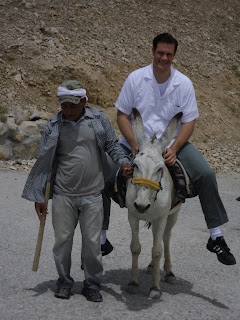




This is the Polish chapel that commemorates where Christ fell the first time. The relief over the entrance and sculpture where created by Thaddeus Zielinsky. It's a beautiful little chapel, a great place to stop by when passing through the area. Here, I met up with the Mexican Via Crucis group that I had encountered at the Church of the Flagellation. I went to the Praetorium to check out the Franciscan's Museum there, but it was closed today; there were some workers rearranging things. So, I stopped into the Church of the Flagellation to pray. A Mexican group came in and started the Stations of the Cross, so I joined them. We left, they headed, probably, to the Church of the Condemnation for the next station. I headed to the Mount of Olives to enter the Greek Orthodox Church of the Scots. Didn't take any pics, because the bearded guy who let me in wouldn't have appreciated that much. It was a beautiful little church covered in icons with a massive chandelier which hung from the neck of an icon of Christ on the ceiling. I headed back to the Franciscan Museum - obviously closed this time. Stopped into the Church of Condemnation, where I saw a man who looked strangely familiar. When he left, I realized he was one of the 'tour guides' who picked up people outside the third station. I told him off once, because I had already received the tour from someone else. I left, went to the Prison of Christ, a Greek Orthodox chapel underground. Here was a bearded priest who sat in one of those monastery-style chairs as if waiting until I left to continue his priestly duties. I prayed in the chapel for a couple minutes and then left. I didn't actually go through the narrow walkway to the area marked Prison of Christ. I've read, though, that there actually isn't any evidence that anything pertaining to Christ is there, it's just the Greek Orthodox claim on the Praetorium - still, underground excavations in Jerusalem are generally good. Made it to the Third Station, knelt down to pray, and whatyaknow, then the Mexican group arrived. I decided to latch on to partake in the Stations on the Via Crucis (I had it with the Franciscans before, but I wanted to do it in a small group).

















































